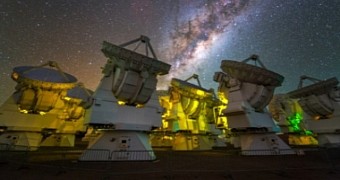A recent paper in the journal Science announces the discovery of a molecule that researchers say sheds new light on the emergence of life on our planet in a star-forming region located about 27,000 light-years from Earth.
The gaseous space region in question is dubbed Sagittarius B2. Looking to gain a better understanding of its makeup and future evolution, researchers used the ALMA Observatory to peer into its insides.
Their focus was on detecting and analyzing the radio waves emitted by various compounds that populate and comprise Sagittarius B2. Much to their surprise, they detected a molecule that they say is a bit out of place.
The odd one out
In their paper in the journal Science, the scientists behind this research project explain that, more often than not, the organic molecules that populate gaseous star-forming regions such as Sagittarius B2 comprise just one so-called backbone made of carbon atoms lined up in a straight chain.
What makes the newly discovered molecule stand out is the fact that it looks nothing like what the scientists were expecting to find. Thus, the molecule, identified as isopropyl cyanide, has a carbon structure that branches off.
As explained by Science Daily, this discovery made by researchers with Cornell University researchers and their colleagues marks the first time one such complex and fairly large molecule has until now been documented in a star-forming gas cloud in interstellar space.
What does this molecule have to do with life on Earth?
According to specialist Rob Garrod with Cornell University's Center for Radiophysics and Space Research, the carbon structure of the isopropyl cyanide molecule found in Sagittarius B2 is similar to that of molecules documented to birth life.
Specifically, it resembles the structure of amino acids, which are the building blocks of proteins. Hence, it could be that the molecules without which life would not be possible on our planet were put together billions of years ago during processes of star formation.
“Understanding the production of organic material at the early stages of star formation is critical to piecing together the gradual progression from simple molecules to potentially life-bearing chemistry,” explains study lead author Arnaud Belloche with the Max Planck Institute for Radio Astronomy.
This theory that star formation processes also birth molecules without which life would not be possible is yet to be confirmed. Still, researchers hope that with the help of the Alma Observatory and other telescopes, they will soon gain a better understanding of what exactly goes down when a space gas cloud starts coughing out stars.

 14 DAY TRIAL //
14 DAY TRIAL //